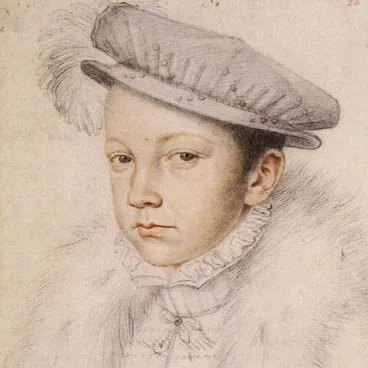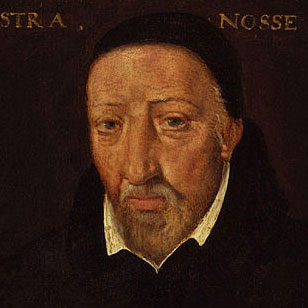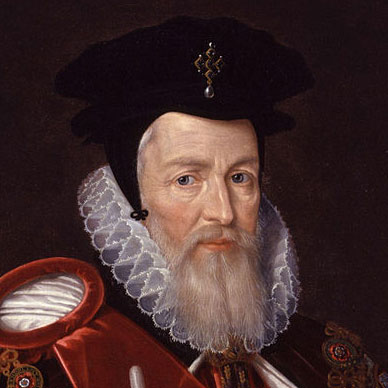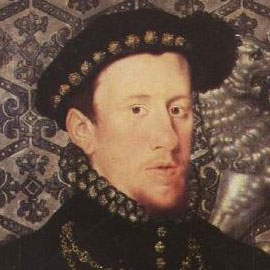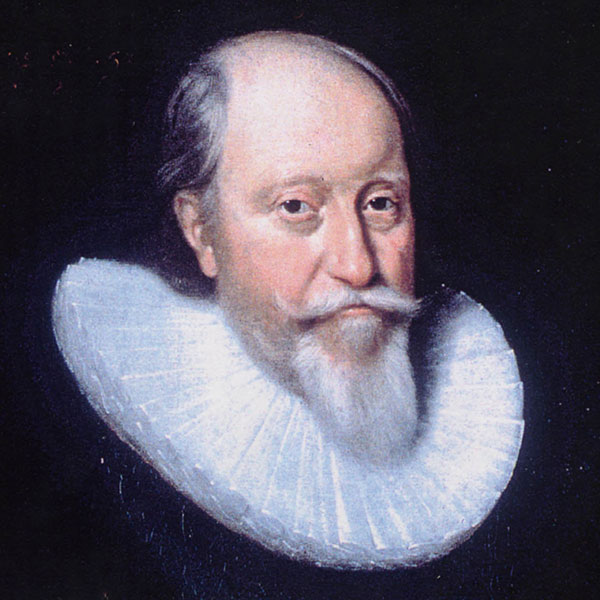Anne of Denmark was the second daughter of Frederick II by his wife, Sophie Mecklenburg-Güstrow, daughter of the Duke and Duchess of Mecklenburg. Anne and her sister, Elisabeth, spent their early years with their maternal grandparents, but returned to join their mother for most of their upbringing at the Danish Court.
In 1585, Frederick II sent an embassy to Edinburgh, involving two ships and sixty men, ostensibly on a mission to recover the Orkney and Shetland Islands that had been provided as the guarantee for the dowry of Margaret, daughter of King Christian I of Norway, when she married James III in 1469. The Danes had never paid the dowry, and the Scots considered the islands were now theirs by right. When negotiations started, the Danes suggested that, if James VI were to marry one of the Danish princesses, it would do much to resolve their claim. James sent an ambassador to Denmark to start tentative negotiations, but proceeded slowly as his choice of wife was being dictated by Elizabeth I of England and he was hoping to be nominated as her heir. Although Elizabeth had proposed Catherine, sister of Henry IV of France, James had heard that she was unattractive (and eight years older than him). With a strongly Lutheran upbringing, a Danish Royal princess was not an unsuitable match from an English viewpoint. In 1588, James sent his old tutor, Peter Young, to Denmark to sound out the availability of Elisabeth, the elder daughter. He reported back that she was already betrothed to the Duke of Braunschweig, but her younger sister Anne, now aged fourteen, was very pretty and worthy of consideration.
Frederick II, who had been most anxious about the delay, died in April 1588, but a Scottish embassy was now sent to Denmark to negotiate terms. In June 1589, George Keith, 5th Earl Marischal arrived in Copenhagen with a retinue of knights as James’s proxy for the wedding in Copenhagen on 20 August 1589. Anne immediately set off for Scotland accompanied in a separate ship by the Earl Marischal, but, as soon as they were at sea, the ships were separated in a tempestuous storm, which swept them back onto the Norwegian coast.
Anne’s vessel was missing for three days and was in a most perilous condition when found. James was horrified and, on 22 October, set out from Leith to collect Anne, who was still in Norway. Although he intended to make an early return to Scotland, this was frustrated by the weather and he stayed in Denmark for the winter. After moving to Kronenburg, yet another marriage ceremony was performed in the presence of Anne’s brother, Christian IV. On 21 April 1590, with winter at last over, they were able to sail from Kronenburg, landing safely at Leith ten days later.
By 6 May, Holyrood, which had been redecorated, was ready to receive them. The Queen’s Coronation took place at the Abbey Kirk eleven days later. Anne was crowned Queen in a ceremony of great pomp. She showed graciouness and charm, and James believed that, as the daughter and sister of a King, she enhanced his claim to the English throne. In accordance with the terms of her considerable dowry, she took possession of the Royal palaces at Falkland, Dumfermline and Linlithgow. Yet in 1593, a Danish embassy was still demanding a just rental from these properties on her behalf. She began expensive renovation work at the palaces, and initial good impressions soon gave way to concerns about her extravagance. This made her angry, and it was reported that ‘she was far more amiable than the features it covered’. Profligate expenditure on masques, dancing and frivolity brought further criticism, not only from the Kirk, and James asked the sensible Sir James Melville to guide her through the worst pitfalls. Despite his bisexuality and her lack of common sense, they were genuinely affectionate. It was Bishop Goodman who recorded: ‘They did love as well as man and wife could do, not conversing together.’
The birth of Prince Henry Frederick at Stirling on 19 February 1594 was greeted with great rejoicing, and by all accounts he became a paragon. James infuriated Anne by insisting that, in accordance with tradition, he should be removed from her care at six months to the guardianship of the Earl of Mar and his elderly mother. Prince Henry was to have the same Presbyterian upbringing as James and remained with them until 1603. This was at odds with the Queen’s own family live in Denmark, and she never forgave James. Tragically, the handsome and athletic Prince died of typhoid in 1612 aged eighteen. Anne was devastated. Princess Elizabeth was born on 19 August 1596, and named after her godmother, the English Queen. The Princess later married Frederick, Elector Palatine, to become the ancestors of the Hanoverian kings. Prince Charles was born at Dunfermline on 19 November 1600, although there were four other children, who died young. At last, there was hope of dynastic stability for the Scottish Crown.
Anne’s frivolous lifestyle was criticised by the Kirk, and Sir Richard Maitland of Thirlestane, the Lord Chancellor, faced the brunt of her annoyance. Much of the disagreement was over her extravagance, and the Exchequer was bare. Although James sold jewellery, he could not be dissuaded from buying new items for Anne and, in 1596, he entertained her brother-in-law, the Duke of Holstein, with lavish banquets, sports and drinking sessions.
In an effort to make his peace with the Queen, Thirlestane asked Buccleuch and the young Sir Robert Ker of Cessford to assist her in removing Prince Henry from Mar’s tutelage. She had proposed that Sir Walter Scott of Buccleuch should replace Mar as guardian, but his lawless background hardly commended him, and the King was furious on hearing of it. He accused Thirlestane of interfering in domestic matters that were not his concern. It did not end there, and, ‘with the bold recklessness of the borderer’, Buccleuch sought to seize the King and the young Prince, having Mar arraigned for treason. Although Thirlestane had not supported any of this, the King used his opportunity to bring his first minister to heal.
Following the death of Elizabeth in 1603, James was immediately declared King of England. Anne did not accompany him on his journey to London, partly because the English ladies-in-waiting were unable to attend her until after Elizabeth’s funeral, and partly as she was again pregnant. Left alone in Scotland, she again tried to bring the management of her household under her own control, and made another effort to regain supervision of the nine-year-old Prince Henry from the Erskines. With Mar accompanying James to England, his mother, Annabella, in accordance with her instructions, refused to hand the Prince over, incensing the Queen so much that she suffered a miscarriage. James immediately sent Mar back from York to escort Prince Henry and the Queen to join him. Thoroughly peeked, she refused to go with him, and the King had to send the Duke of Lennox to control them, and to bring them both south. James wrote Anne an affectionate letter, saying: ‘Pray God, my heart, to preserve you and all the bairns, and to send me a blithe meeting with you and a couple of them.’ Although she was persuaded to travel with Lennox, she still wanted reparation from Mar. Yet the Erskines had acted in accordance with James’s request, and, when at last she arrived at Windsor, James arranged for them to be reconciled.
Queen Anne’s arrival in London heralded a new age in the production of allegorical masques to supplement the festivities that she arranged. While travelling south, she had been welcomed at Althorpe with Ben Jonson’s Masque of the Fairies in which she was depicted as Oriana. In London, there were entertainments by Thomas Dekker and others, leading to immediate concern at her extravagance and her wearing of ‘gauzy apparel’ that was ‘too curtizan-like’. Anne’s expenditure could not be held in check, and in 1605 to universal horror, she spent £50,000 on entertainment, which left her continuously in debt. Her progress to Bath and Bristol in 1613, with its related entertainments, cost £30,000. Yet her Danish Royal blood brought prestige for the Crown both with foreign ambassadors and the Ladies of the Court, doing much to soften rivalries between Scottish and English ladies. Always financially profligate himself, James supported Anne when she set about building the Queen’s House at Greenwich, and she transformed Somerset House, which was renamed Denmark House. While in England Anne, who spent much time separated from James, flirted with Roman Catholicism, and although he strongly opposed her views, it is probable that she ended her life in the Catholic faith. She died at Hampton Court on 2 March 1619 aged forty-four, but despite her wayward character and James’s homosexual inclinations, they remained close and affectionate.



